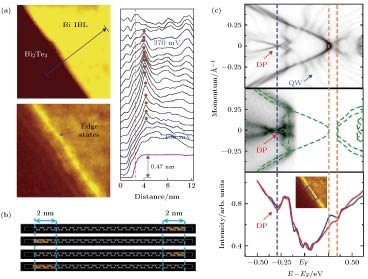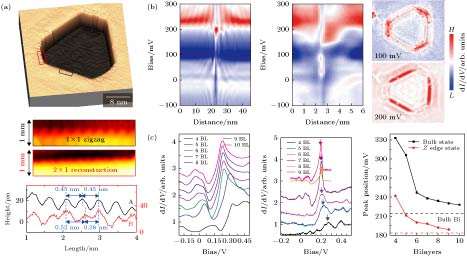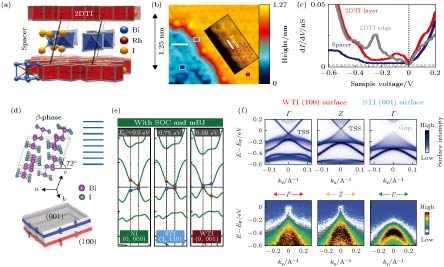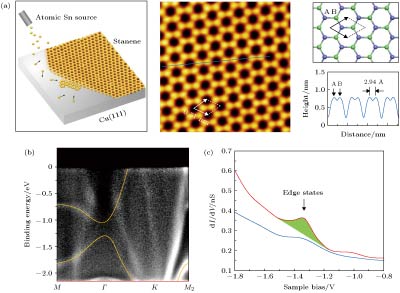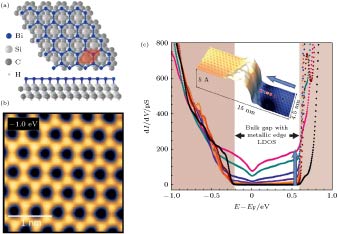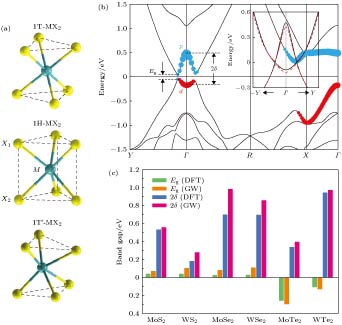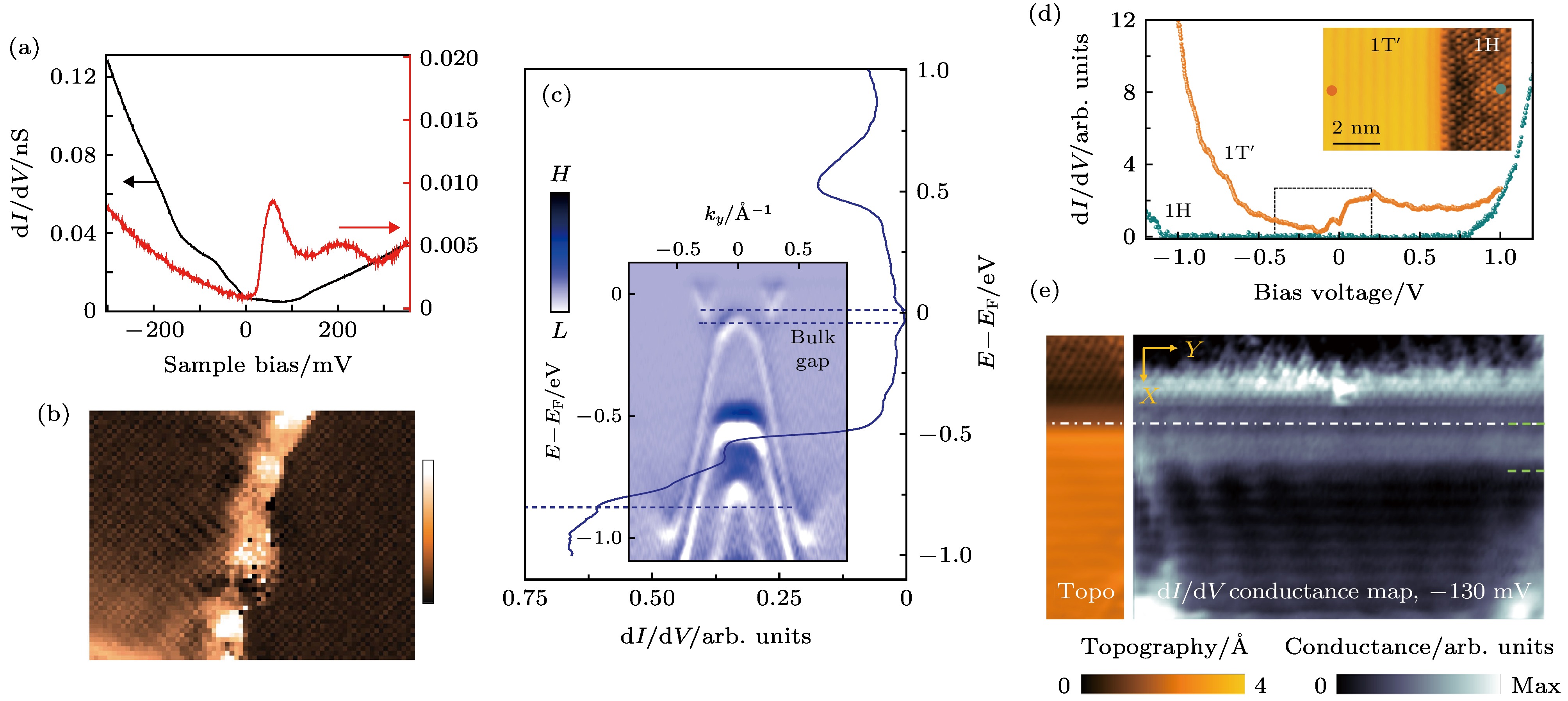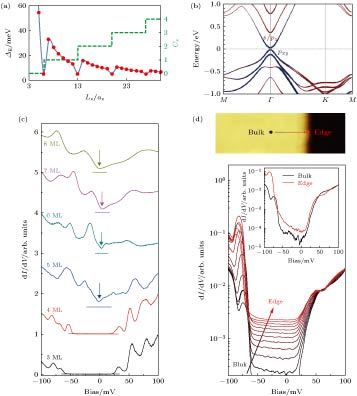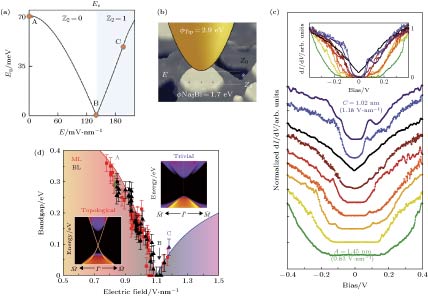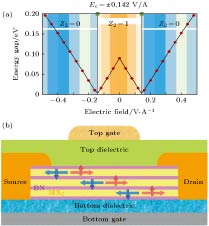-
拓扑物态是近年来在凝聚态科学领域快速兴起的一个分支, 其中二维拓扑绝缘体由于在基础研究和应用前景方面存在巨大潜力而受到广泛关注. 二维拓扑绝缘体具有绝缘性体态和导电性边界态, 其边界态受时间反演对称性保护, 不会被边界弱无序杂质所背散射, 从而形成无耗散的边界导电通道. 由于边界态只能沿着两个方向传播, 意味着比三维拓扑绝缘体有更少的散射通道和更强的稳定性, 对发展低能耗的集成电路意义重大. 在研究二维材料的诸多实验手段当中, 扫描隧道显微镜具有高空间与高能量分辨率测量, 能够局域地探测材料表面实空间的电子态结构, 直接探测到二维材料的边界态, 尤其适合表征其拓扑特性. 本文追溯了二维拓扑绝缘体的研究背景, 对当前广泛关注的几类研究体系, 从谱学方面详细展现一维边界态的非平庸拓扑特性. 结合理论计算证明: 一维拓扑边界态局域于材料的体能隙之内, 在晶体的边界处稳定存在, 并表现出一定的空间延展性. 最后介绍了通过结构和外场等手段对二维拓扑材料的物性进行调控, 展望了在未来自旋功能电子器件方面潜在的应用.Topological state is a rapidly emerging branch of condensed matter physics in recent years, among which two-dimensional topological insulators (2D TIs) have attracted wide attentions due to their great potential in basic research and applications. The 2D TI has insulating bulk state and conductive edge state. Its edge state is protected by time inversion symmetry and will not be backscattered by weak disordered impurities on the boundaries, thus forming a dissipationless edge conductive channel. Compared with 3D TIs, the edge state of 2D TIs can only propagate in two directions, meaning stronger anti-interference with robustness, thus is of great significance for the development of advanced integrated circuits with low energy consumption. Among many experimental methods for studying two-dimensional materials, scanning tunneling microscopy is a surface-sensitive tool with high atomic and energy resolution to locally detect the electronic structure of the material surface. By detecting the edge state of 2D materials in real space, it is particularly suitable for characterizing their topological properties. This paper traces the research progress of 2D TIs, and illustrates their spectroscopic evidences to resolve the nontrivial properties of the one-dimensional edge states. Combined with theoretical calculations, the topological edge states are verified to reside within the bulk energy gap, as well as being localized in the vicinity of step boundaries with a specific spatial distribution in real space. Finally, we discuss the tunability and manipulations of 2D topological materials through structural and external fields, which show promising prospects for applications in future spintronics and energy-saving devices.
-
Keywords:
- scanning tunneling microscopy /
- two-dimensional topological insulators /
- topological edge states
[1] Qi X L, Zhang S C 2011 Rev. Mod. Phys. 83 1057
 Google Scholar
Google Scholar
[2] Kane C L, Mele E J 2005 Phys. Rev. Lett. 95 146802
 Google Scholar
Google Scholar
[3] Haldane F D 2017 Rev. Mod. Phys. 89 040502
 Google Scholar
Google Scholar
[4] Min H, Hill J E, Sinitsyn N A, Sahu B R, Kleinman L, Macdonald A H 2006 Phys. Rev. B 74 165310
 Google Scholar
Google Scholar
[5] Bernevig B A, Hughes T L, Zhang S C 2006 Science 314 1757
 Google Scholar
Google Scholar
[6] Ren Y, Qiao Z, Niu Q 2016 Rep. Prog. Phys. 79 066501
 Google Scholar
Google Scholar
[7] Konig M, Wiedmann S, Brjne C, Roth A, Buhmann H, Molenkamp L W, Qi X L, Zhang S C 2007 Science 318 766
 Google Scholar
Google Scholar
[8] Liu C, Hughes T L, Qi X L, Wang K, Zhang S C 2008 Phys. Rev. Lett. 100 236601
 Google Scholar
Google Scholar
[9] Knez I, Du R R, Sullivan G 2011 Phys. Rev. Lett. 107 136603
 Google Scholar
Google Scholar
[10] Murakami S 2006 Phys. Rev. Lett. 97 236805
 Google Scholar
Google Scholar
[11] Yang F, Miao L, Wang Z F, Yao M Y, Zhu F, Song Y R, Wang M X, Xu J P, Fedorov A V, Sun Z, Zhang G B, Liu C, Liu F, Qian D, Gao C L, Jia J F 2012 Phys. Rev. Lett. 109 016801
 Google Scholar
Google Scholar
[12] Kim S H, Jin K H, Park J, Kim J S, Jhi S H, Kim T H, Yeom H W 2014 Phys. Rev. B 89 155436
 Google Scholar
Google Scholar
[13] Drozdov I K, Alexandradinata A, Jeon S, NadjPerge S, Ji H, Cava R J, Andrei Bernevig B, Yazdani A 2014 Nat. Phys. 10 664
 Google Scholar
Google Scholar
[14] Kawakami N, Lin C L, Kawai M, Arafune R, Takagi N 2015 Appl. Phys. Lett. 107 031602
 Google Scholar
Google Scholar
[15] Du H, Sun X, Liu X, Wu X, Wang J, Tian M, Zhao A, Luo Y, Yang J, Wang B, Hou J G 2016 Nat. Commun. 7 10814
 Google Scholar
Google Scholar
[16] Yeom H W, J in, K H, Jhi S H 2016 Phys. Rev. B 93 075435
 Google Scholar
Google Scholar
[17] Peng L, Xian J J, Tang P, Rubio A, Zhang S C, Zhang W, Fu Y S 2018 Phys. Rev. B 98 245108
 Google Scholar
Google Scholar
[18] Liu Z, Liu C X, Wu Y S, Duan W H, Liu F, Wu J 2011 Phys. Rev. Lett. 107 136805
 Google Scholar
Google Scholar
[19] Song Z D, Fang Z, Fang C 2017 Phys. Rev. Lett. 119 246402
 Google Scholar
Google Scholar
[20] Schindler F, Wang Z J, Vergniory M G, Cook A M, Murani A, Sengupta S, Kasumov A Y, Deblock R, Jeon S, Drozdov I, Bouchiat H, Guéron S, Yazdani A, Bernevig B A, Neupert T 2018 Nat. Phys. 14 918
 Google Scholar
Google Scholar
[21] Weng H, Dai X, Fang Z 2014 Phys. Rev. X 4 011002
 Google Scholar
Google Scholar
[22] Wu R, Ma J Z, Nie S M, Zhao L X, Huang X, Yin J X, Fu B B, Richard P, Chen G F, Fang Z, Dai X, Weng H M, Qian T, Ding H, Pan S H 2016 Phys. Rev. X 6 021017
 Google Scholar
Google Scholar
[23] Li X B, Huang W K, Lü Y Y, Zhang K W, Yang C L, Zhang B B, Chen Y B, Yao S H, Zhou J, Lu M H, Sheng L, Li S C, Jia J F, Xue Q K, Chen Y F, Xing D Y 2016 Phys. Rev. Lett. 116 176803
 Google Scholar
Google Scholar
[24] Liu S, Wang M X, Chen C, Xu X, Jiang J, Yang L X, Yang H F, Lü Y Y, Zhou J, Chen Y B, Yao S H, Lu M H, Chen Y F, Felser C, Yan B H, Liu Z K, Chen Y L 2018 APL Mater. 6 121111
 Google Scholar
Google Scholar
[25] Manzoni G, Gragnaniello L, Autes G, Kuhn T, Sterzi A, Cilento F, Zacchigna M, Enenkel V, Vobornik I, Barba L, Bisti F, Bugnon P, Magrez A, Strocov V N, Berger H, Yazyev O V, Fonin M, Parmigiani F, Crepaldi A 2016 Phys. Rev. Lett. 117 237601
 Google Scholar
Google Scholar
[26] Pauly C, Rasche B, Koepernik K, Liebmann M, Pratzer M, Richter M, Kellner J, Eschbach M, Kaufmann B, Plucinski L, Schneider Claus M, Ruck M, van den Brink J, Morgenstern M 2015 Nat. Phys. 11 338
 Google Scholar
Google Scholar
[27] Noguchi R, Takahashi T, Kuroda K, Ochi M, Shirasawa T, Sakano M, Bareille C, Nakayama M, Watson M D, Yaji K, Harasawa A, Iwasawa H, Dudin P, Kim T K, Hoesch M, Kandyba V, Giampietri A, Barinov A, Shin S, Arita R, Sasagawa T, Kondo T 2019 Nature 566 518
 Google Scholar
Google Scholar
[28] Luo W, Xiang H 2015 Nano Lett. 15 3230
 Google Scholar
Google Scholar
[29] Zhou J J, Feng W, Liu C C, Guan S, Yao Y 2014 Nano Lett. 14 4767
 Google Scholar
Google Scholar
[30] Liu C C, Feng W, Yao Y 2011 Phys. Rev. Lett. 107 076802
 Google Scholar
Google Scholar
[31] Xu Y, Yan B, Zhang H J, Wang J, Xu G, Tang P, Duan W, Zhang S C 2013 Phys. Rev. Lett. 111 136804
 Google Scholar
Google Scholar
[32] Molle A, Goldberger J, Houssa M, Xu Y, Zhang S C 2017 Nat. Mater. 16 163
 Google Scholar
Google Scholar
[33] Oughaddou H, Enriquez H, Tchalala M R, Yildirim H, Mayne A J, Bendounan A, Dujardin G, Ali M A, Kara A 2015 Prog. Surf. Sci. 90 46
 Google Scholar
Google Scholar
[34] Liu N, Bo G, Liu Y, Xu X, Du Y, Dou S X 2019 Small 15 1805147
 Google Scholar
Google Scholar
[35] Zhu F F, Chen W J, Xu Y, Gao C L, Guan D D, Liu C H, Qian D, Zhang S C, Jia J F 2015 Nat. Mater. 14 1020
 Google Scholar
Google Scholar
[36] Xu C Z, Chan Y H, Chen P, Wang X, Flötotto D, Hlevyack J A, Bian G, Mo S K, Chou M Y, Chiang T C 2018 Phys. Rev. B 97 035122
 Google Scholar
Google Scholar
[37] Deng J, Xia B, Ma X, Chen H, Shan H, Zhai X, Li B, Zhao A, Xu Y, Duan W, Zhang S C, Wang B, Hou J G 2018 Nat. Mater. 17 1081
 Google Scholar
Google Scholar
[38] Reis F, Li G, Dudy L, Bauernfeind M, Glass S, Hanke W, Thomale R, Schfer J, Claessen R 2017 Science 357 287
 Google Scholar
Google Scholar
[39] Qian X, Liu J, Fu L, Li J 2014 Science 346 1344
 Google Scholar
Google Scholar
[40] Peng L, Yuan Y, Li G, Yang X, Xian J J, Yi C J, Shi Y G, Fu Y S 2017 Nat. Commun. 8 659
 Google Scholar
Google Scholar
[41] Tang S, Zhang C, Wong D, Pedramrazi Z, Tsai H Z, Jia C, Moritz B, Claassen M, Ryu H, Kahn S, Jiang J, Yan H, Hashimoto M, Lu D, Moore R G, Hwang C C, Hwang C, Hussain Z, Chen Y, Ugeda M M, Liu Z, Xie X, Devereaux T P, Crommie M F, Mo S K, Shen Z X 2017 Nat. Phys. 13 683
 Google Scholar
Google Scholar
[42] Jia Z Y, Song Y H, Li X B, Ran K, Lu P, Zheng H J, Zhu X Y, Shi Z Q, Sun J, Wen J, Xing D, Li S C 2017 Phys. Rev. B 96 041108
 Google Scholar
Google Scholar
[43] Pan X C, Chen X, Liu H, Feng Y, Wei Z, Zhou Y, Chi Z, Pi L, Yen F, Song F, Wan X, Yang Z, Wang B, Wang G, Zhang Y 2015 Nat. Commun. 6 7805
 Google Scholar
Google Scholar
[44] Li Y N, Gu Q Q, Chen C, Zhang J, Liu Q, Hu X Y, Liu J, Liu Y, Ling L S, Tian M L, Wang Y, Samarth N, Li S Y, Zhang T, Feng J, Wang J 2018 Proc. Natl. Acad. Sci. USA 115 9503
 Google Scholar
Google Scholar
[45] Kang D, Zhou Y, Yi W, Yang C, Guo J, Shi Y, Zhang S, Wang Z, Zhang C, Jiang S, Li A, Yang K, Wu Q, Zhang G, Sun L, Zhao Z 2015 Nat. Commun. 6 7804
 Google Scholar
Google Scholar
[46] Zhu L, Li Q, Lü Y, Li S, Zhu X, Jia Z, Chen Y B, Wen J, Li S 2018 Nano Lett. 18 6585
 Google Scholar
Google Scholar
[47] Chen P, Pai W W, Chan Y H, Sun W L, Xu C Z, Lin D S, Chou M Y, Fedorov A V, Chiang T C 2018 Nat. Commun. 9 2003
 Google Scholar
Google Scholar
[48] Ugeda M M, Pulkin A, Tang S, Ryu H, Wu Q, Zhang Y, Wong D, Pedramrazi Z, Martín-Recio A, Chen Y, Wang F, Shen Z X, Mo S K, Yazyev O V, Crommie M F 2018 Nat. Commun. 9 3401
 Google Scholar
Google Scholar
[49] Wang Z, Sun Y, Chen X Q, Franchini C, Xu G, Weng H, Dai X, Fang Z 2012 Phys. Rev. B 85 195320
 Google Scholar
Google Scholar
[50] Tang P, Chen P, Cao W, Huang H, Cahangirov S, Xian L, Xu Y, Zhang S C, Duan W, Rubio A 2014 Phys. Rev. B 90 121408
 Google Scholar
Google Scholar
[51] Hu J, Alicea J, Wu R, Franz M 2012 Phys. Rev. Lett. 109 266801
 Google Scholar
Google Scholar
[52] Lu Y, Xu W, Zeng M, Yao G, Shen L, Yang M, Luo Z, Pan F, Wu K, Das T, He P, Jiang J, Martin J, Feng Y P, Lin H, Wang X S 2015 Nano Lett. 15 80
 Google Scholar
Google Scholar
[53] Xiao X, Yang S A, Liu Z, Li H, Zhou G 2015 Sci. Rep. 5 789
 Google Scholar
Google Scholar
[54] Chen R, Xu D H, Zhou B 2017 Phys. Rev. B 95 245305
 Google Scholar
Google Scholar
[55] Xia H, Li Y, Cai M, Qin L, Zou N, Peng L, Duan W, Xu Y, Zhang W, Fu Y S 2019 ACS Nano 13 9647
 Google Scholar
Google Scholar
[56] Pan H, Wu M, Liu Y, Yang S A 2015 Sci. Rep. 5 14639
 Google Scholar
Google Scholar
[57] Collins J L, Tadich A, Wu W, Gomes L C, Rodrigues J N B, Liu C, Hellerstedt J, Ryu H, Tang S, Mo S K, Adam S, Yang S A, Fuhrer M S, Edmonds M T 2018 Nature 564 390
 Google Scholar
Google Scholar
[58] Nayak C, Simon S H, Stern A, Freedman M, Das Sarma S 2008 Rev. Mod. Phys. 80 1083
 Google Scholar
Google Scholar
-
图 1 (a)拓扑绝缘体的能带结构示意图, 红色和蓝色分别表示自旋取向相反的两支边界态; (b) 二维拓扑绝缘体每个边界处存在两支相对运动的自旋流, 电荷流与电子自旋方向关联; (c) 量子自旋霍尔边缘非磁性杂质散射的两种可能路径, 顺时针(蓝色)或逆时针(红色)旋转的方式绕过此杂质, 会额外增加π或–π的相位, 使得自旋为1/2的电子路径相互抵消, 从而禁止背散射; (d) Haldane模型所描述的石墨烯晶格, 空白和黑点圆圈分别代表两类子晶格, 晶格内不同区域a和b分别产生交错的反向磁通, 整个晶格不存在净磁通; (e) BHZ模型中, 平庸绝缘体经过能带反转和自旋轨道耦合重新打开能隙, 实现拓扑非平庸绝缘体; 蓝色和红色表示能带的奇偶宇称性, 拓扑相变过程中伴随着能带宇称的交换((a)−(c)[1], (d)[3])
Fig. 1. (a) Energy spectrum of the topological insulator, there exist gapless edge states of spin-up (red) and spin-down (blue) connecting the conduction and valence band; (b) the one-dimensional (1D) conducting channels are spin polarized and spatially separated in a quantum spin Hall (QSH) insulator; (c) A QSH edge state can be scattered in two possible directions by a nonmagnetic impurity; clockwise (blue) and counterclockwise (red), accompanied with the spin rotated by π and –π, respectively, a quantum mechanical phase difference of 2π between the two paths leads to destructive interference, resulting in the suppression of backscattering; (d) the Haldane model of a graphene-like structure, the open and solid circles stand for two sublattices, within which different magnetic fluxes (equal but reversal direction) are assumed to passing through regions a and b; in each hexagonal cell, there is no net magnetic flux; (e) illustration of the band inversion mechanism in a BHZ model, blue and red colors represent bands with opposite parities. In the presence of SOC, the topologically trivial bands are in an inverted order and converted into a topological insulator. (a)−(c)[1], and (e)[3].
图 2 (a) 理论计算HgTe和CdTe能带结构, 超过临界厚度时HgTe将发生能带反转[5]; (b) 通过输运实验, 测量HgTe/CdTe量子阱的量子化霍尔电导平台, Ⅰ表示样品厚度小于临界值, 处于平庸绝缘体状态, Ⅱ、Ⅲ、Ⅳ表示样品厚度大于临界值, 体系进入量子自旋霍尔态, 量子化电导与样品的横向尺寸(L和W)无关[7]
Fig. 2. (a) Bulk energy bands of HgTe and CdTe near the Γ point. Bellows are schematic illustration for the subbands of CdTe/HgTe quantum well in the normal (d < dc) and inverted regime (d > dc), respectively[5]. (b) experimentally measured longitudinal resistance of various normal (d = 5.5 nm) (Ⅰ) and inverted (d = 7.3 nm) (Ⅱ, Ⅲ, and Ⅳ) devices as a function of gate voltage. Quantized resistance plateaus are observed due to the perfectly conducting edge states of a QSH insulator, which is regardless of the lateral dimensions (L and W)[7].
图 3 (a) Bi2Te3表面1 BL层厚Bi(111)薄膜台阶边缘的形貌图和实空间电导成像, 存在不随能量变化的一维边界态; (b) 理论计算显示台阶处的能带结构存在拓扑边界态, 穿透深度~2 nm; (c) 1 BL层厚Bi(111)薄膜的电子能带结构, 从上到下分别为DFT计算结果、ARPES和STS谱数据, 显示出边界电子态密度增强发生于体能隙内, DP表示狄拉克点, QW表示量子阱态; 橙色虚线代表最顶层1 BL Bi(111)薄膜的体态能隙[11]
Fig. 3. (a) STM image and STS map of 1 BL Bi/Bi2Te3 island, showing apparent 1D edge states near the step. The red dashed lines indicate the location of step edges. The red dots mark the peak position of the edge states. (b) real-space charge density distribution of the edge states by calculations. (c) the electronic structures of 1 BL Bi/Bi2Te3. Calculated density of bands (up), ARPES spectrum (middle), STS of the step edge and the inner terrace (bottom, blue and red, respectively) are aligned by the Dirac point “DP” the blue dashed line, “QW” marks the quantum well states. Adapted from [11].
图 4 (a) 翘曲型的双原子层Bi(111)结构, 夹角为120°的两条边界自然地形成A和B边两种边界, Bi原子与衬底存在不同距离高度; (b) 对比Bi(111)两种边界以及远离边界处的扫描隧道谱(STS, 可以看成实空间局域电子态密度随着能量的分布); (c) 183 meV能量下电子态密度的空间分布图, 显示A边存在拓扑边界态, 而B边则不存在; (d) 沿着A边所做的STS线谱(沿着边界等间距取得一系列STS谱, 并组合成二维分布的谱图), 表明台阶边缘处存在一维边界态(红色高亮部分), 体内也能观测到电子态散射所形成的驻波; (e) 傅里叶变换结果显示, 动量空间存在q1和q2两类散射通道; (f) 理论计算显示, 自旋选择散射允许q1散射通道存在, 禁止q*(背散射通道)存在[13]
Fig. 4. (a) Schematics of 1 BL Bi atomic structure with two types of edges. (b) point spectroscopy at the two different types of edge A (red) and B (blue) and on the surface away from the edges (grey). (c) STS maps for a hexagonal pit-like defect at +183 meV. High conductance (red) is observed at every other edge (type A). (d) spectroscopy along the type A step edge. 1D singularity exactly at the edge is observed by approaching the step edge, spectra far from the edges show the 2D surface electronic properties of Bi(111). (e) 1D Fourier transform of the quasi-particle interference (QPI) within the edge channel. Two QPI branches (q1 and q2) are identified, with the q1 branch corresponding to the 1D edge state and q2 branch from the projection of 2D surface states. (f) dispersion calculation of the scattering within the 1D edge mode. Considering the spin properties, only scattering between the states of similar spin (q1) is allowed, while the backscattering channel (q*) is strongly suppressed. Adapted from [13].
图 5 (a) Bi(111)薄膜呈现长短两种类型的台阶边界, 交替排布并形成六边形, 高分辨STM图显示边界分别为zigzag(黑)和2 × 1重构(红)两种结构, 表现为不同的面内晶格常数; (b) 1 × 1和2 × 1两种边界处各自的拓扑边界态, 展现出不同的空间和能量分布, 右边为不同能量下态密度的实空间分布, 显示两种结构均展现一维特性的边界态; (c) 随着层厚的增加(4—10 BL), 无论是台面上(左)还是边界处(中), 范霍夫奇点的峰位均向低能量方向移动, 直到趋近于Bi单晶(右). 这表明1 BL层厚Bi(111)的二维拓扑特性并不受衬底薄膜的厚度而影响[17]
Fig. 5. (a) Two types of edge structures, zigzag and 2 × 1 reconstructed edge, coexist alternately at the boundaries of 1 BL Bi islands. Displayed from the atomically resolved STM images and line profiles, the two edge show different in-plane lattice constants. (b) 2 D plot of tunneling spectra across the zigzag and 2 × 1 edge, respectively, exhibiting remarkably different energy and spatial distributions. Right images are the spectroscopic mapping, showing alternating appearance of edge states for the 2 × 1 edge at 100 mV and zigzag edge at 200 mV. (c) a series of STS spectra recorded on the Bi terrace (left) and at the step edge (middle) from 4 to 10 BL. Spectra are shifted vertically. Right is the energy evolution for the topological edge states with various thicknesses of underlying Bi substrate. Adapted from [17].
图 6 (a) ZrTe5晶体台阶附近的STS谱, 台面上具有~100 meV的体能隙, 台阶边缘处(红色曲线)态密度不为零, 表明存在位于体能隙内的边界态[22]; (b) 理论计算的态密度分布, 插图为顶层台阶处态密度, 和实验结果一致[22]; (c) 不同能量下ZrTe5台阶附近态密度的实空间分布图, 显示空间均匀分布的一维边界态[23]; (d) 理论计算的ZrTe5能带结构, 显示出狄拉克型色散的拓扑边界态[22]; (e) 体能隙中态密度积分强度逐渐远离台阶的变化, 给出边界态的衰减长度约为1.5 nm[22], 插图为第一性原理的计算结果((c)[23])
Fig. 6. (a) STS spectra along a line perpendicular to a monolayer step edge of ZrTe5. Red curves are tunneling spectra measured near the step edge. The inset shows the STM image of the step[22]. (b) calculated density of states of the top monolayer. The inset shows the edge states along the chain direction[22]. (c) STM topography of the step and the corresponding STS mapping taken at various bias voltages[23]. (d) calculated band dispersions of the edge states of the monolayer along the chain direction[22]. (e) normalized conductance integral within the gap plotted as a function of the distance from the edge. The exponential fitting gives a decay length ξ~1.5 nm[22]. Inset plots the calculated result with ξ~1.6 nm ((c) is adapted from [23]).
图 7 (a) Bi14Rh3I9晶体结构示意图, 分为平庸绝缘体的[Bi2I8]2-插层和二维拓扑绝缘体[(Bi4Rh)3I]2+层, 垂直方向上晶格间距为1.25 nm; (b) 不同原子层和台阶边缘的结构, 蓝色为[Bi2I8]2–层, 黄色为蜂窝状结构的[(Bi4Rh)3I]2+表面; (c) 不同区域电导谱比较, 在二维拓扑绝缘体[(Bi4Rh)3I]2+台阶边, 体能隙之内出现了明显的态密度增强, 费米能级附近的电导下降来自于库仑阻塞效应; (d) β-Bi4I4的准一维晶体结构, 沿着a和c方向都很容易解离, 分别得到(001)和(100)表面; (e) 理论计算的β-Bi4I4能带结构图, 不考虑SOC时为大能隙的平庸绝缘体, 考虑SOC则显示存在能带反转和拓扑表面态, 红色和蓝色圆圈表示能带宇称的奇偶性; (f) (100)侧表面观察到准一维狄拉克拓扑表面态, 而(001)顶表面没有拓扑表面态, 证明β-Bi4I4是三维弱拓扑绝缘体((a)−(c)[26], (d)—(f)[27])
Fig. 7. (a) Atomic model of Bi14Rh3I9, containing the normal insulating [Bi2I8]2– layer and 2 D TI [(Bi4Rh)3I]2+ layer. The distance along the vertical direction is 1.25 nm. (b) STM image with the step edge of [(Bi4Rh)3I]2+ layer (yellow). Inset is the zoomed-in view of the step edge in a honeycomb lattice. (c) STS spectra taken at the positions marked in (b) by the corresponding colors. The linearly vanishing STS intensity around EF is attributed to a two-dimensional Coulomb gap. (d) Crystal structure of the β-Bi4I4, which is easily cleaved along a and c directions, resulting in the (001) and (100) surfaces. (e) Band inversions of the β-phase with inclusion of SOC. The red and blue circles label respectively the even and odd parities for the bulk bands at the M and L points. NI stands for normal insulator. (f) The topological surface states at the side surface (100) for the weak TI and the strong TI phase along distinct high-symmetry lines. Up, calculations; down, ARPES data. (a)−(c) are adapted from [26], and (d)−(f) are from [27].
图 8 (a) Cu(111)表面外延生长的锡烯, 原子分辨显示结构为蜂窝状排布, 且相邻锡原子(A和B)的表观高度相同, 表明两套子晶格没有发生翘曲; (b) ARPES表明布里渊区Γ点打开0.3 eV的体能隙(黄色), 其余能带均来自于Cu(111)衬底; (c)锡烯台面上和台阶处的STS谱对比, 电子态密度的谱权重在偏压为–1.2 V到–1.45 V之间发生显著增加(绿色阴影部分), 正是来源自边界态, 且位于体能隙之内[37]
Fig. 8. (a) Sample growth set-up and the high-resolution STM image of the stanene film. The profile shows that the adjacent Sn atoms are identical in apparent height, confirming the atomic model of the honeycomb stanene. (b) ARPES spectra of 0.9 ML stanene along the M-Γ-K-M2 directions. The orange lines outline the energy bands which are contributed mainly by orbitals of Sn. Other branches come from the Cu(111) substrate. (e) STS spectra taken at the edge and center of the stanene flakes. The green shadowed regions between –1.2 V and –1.45 V high light the differences of enhanced spectral weight, which is attributed to the edge states. Adapted from [37].
图 9 (a) 碳化硅(SiC)表面的单层铋烯的晶格结构示意图; (b) STM原子分辨显示无翘曲的Bi表面原子呈蜂窝状排布; (c) 单层台阶附近的STS分布, 靠近边界时, 铋烯由绝缘态变为金属态, 体能隙内出现显著的拓扑边界态, 插图为靠近边界时采集一系列STS谱的不同位置[38]
Fig. 9. (a) Sketch of a bismuthene layer placed on the SiC(0001) substrate. (b) close-up STM images for the occupied states, confirming the formation of Bi honeycombs. (c) STS spectra at different distances to the edge. A large gap of ~0.8 eV is observed in bulk bismuthine (black curve). Upon approaching the edge, additional signal of increasing strength emerges that fills the entire gap. Inset is the measurement locations near the boundary. Adapted from [38].
图 10 (a) TMDC的三种晶体结构; (b) 1 T’-MoS2通过p-d能带反转和自旋轨道耦合打开能隙, Eg为材料的本征半导体能隙大小, 2δ表示能带反转的能隙大小, 插图为有(红色)和无(黑色)自旋轨道耦合时的能带结构; (c) 利用不同计算方法分别得到TMDC薄膜的本征能隙和反带所打开能隙的大小对比[39]
Fig. 10. (a) Atomistic structures of three types of monolayer MX2, M stands for (W, Mo) and X stands for (Te, Se, S). (b) band structure of 1 T’-MoS2. The conduction and valence bands display a camelback shape near Γ, suggestive of band inversion with a large inverted gap of ~0.6 eV. Eg is the fundamental gap and 2δ is the inverted gap. Inset compares the band structures with (red) and without (black) SOC. (c) comparison for the fundamental and inverted gaps of all six 1 T’-MX2 materials by different calculation methods. Adapted from [39].
图 11 (a) 在1 T’-WTe2单晶表面台面上(黑)和台阶处(红)的STS谱; (b) 台阶附近单能量电子态密度分布图, 显示存在一维的边界态, 且不随台阶不规则形状而变化; (c) 1 T’-WTe2薄膜的STS谱和ARPES测量沿着Γ-Y方向的能带结构对照, 证实其平均能隙大小为(56 ± 14) meV. 样品表面进行了K原子掺杂处理, 以使得两者的化学势保持一致; (d) 1 H相和1 T’相WSe2的STS谱对比, 前者是大能隙的普通绝缘体, 后者是二维拓扑绝缘体, 插图为原子高分辨相; (e) 不同相之间畴界的形貌(左)和能隙内特定能量下能态密度的空间分布(右), 畴界处形成一维的拓扑边界态((a)和(b)[40], (c)[41], (d)和(e)[48])
Fig. 11. (a) Typical tunneling spectra measured at the step edge (red curve) and on the inner terrace (black curve). (b) spectroscopic mapping of the 1 T’-WTe2 step at selected voltages, showing the spatial distribution residing at an irregular shaped step edge. (c) STS spectrum and ARPES data acquired in the bulk of monolayer 1 T’-WTe2, which are aligned in energy in a K-doped sample for proper comparison. (d) STS spectra obtained in the 1 T’ (orange) and 1 H (blue) regions of single-layer WSe2. The former one is a normal insulator with a large band gap, the latter is a 2D TI. Inset shows an STM image of coexisting 1 T’ and 1 H regions with a well-ordered interface. (e) STM topography and experimental STS map (–130 meV) of the 1 T’-1 H interface. Dashed line shows interface location. High contrast are the edge states along the crystalline phase boundaries. (a)−(b) are adapted from[40], (c) are from [41] and (c)−(d) are from [48].
图 12 (a) Bi(110)的翘曲双原子层结构, h代表翘曲的程度; (b) Bi(110)的拓扑性质和能隙大小随翘曲高度变化的关系图, 当h < 0.1 Å时成为非平庸拓扑绝缘体; (c) 2层和4层的Bi(110)台阶边处STS谱有所增强, 显示拓扑边界态的存在[52]
Fig. 12. (a) Crystal structure of 2D Bi(110) thin films. Buckling is defined in terms of the height difference (h) between two atoms of the same monolayer. (b) buckling-dependent energy gap at Dirac point of Bi(110) film. When h is smaller than 0.1Å, the Bi(110) film is converted into a 2D TI with topological nontrivial properties. (c) STS spectra taken from the edge to inside of the terrace of 2 ML (up) and 4 ML (down) Bi(110) film. The gap size determined far away from the edges is indicated by dash lines on both STS maps. Adapted from [52].
图 13 (a) 早期理论计算的Na3Bi的能隙(红点蓝线)和陈数(绿色曲线)随薄膜层厚的变化情况; (b) 最近理论计算三层Na3Bi薄膜的能带结构, 存在s-pxy能带反转, 自旋轨道耦合效应使得费米能级附近打开能隙, 成为二维拓扑绝缘体; (c) 实验上不同层厚Na3Bi薄膜的STS谱, 从体相的无能隙三维狄拉克半金属转变为有能隙的二维拓扑绝缘体; (d) 三层Na3Bi薄膜的STM形貌(上), 靠近台阶边缘时一系列STS谱的演化(下); 能隙内态密度逐渐增强, 表明存在拓扑边缘态, 插图为台面和台阶处STS谱采用对数坐标下的对比((a)[54], (b)−(d)[55])
Fig. 13. (a) Confinement-induced bulk gap (red dots) and the spin Chern number (green dashed line) as a function of the film thickness, showing a periodic modulation between normal insulator and 2D TI. (b) calculated band structure of 3 ML Na3Bi with SOC, showing a s-p band inversion. The including of SOC opens a Dirac gap near Γ point. (c) series of STS spectra recorded on Na3Bi terraces with different thicknesses (3-8 ML), showing a phase transition from a bulk gapless Dirac semimetal to a gapped insulator. All spectra are shifted vertically for clarity. (d) STS spectra in a logarithmic scale recorded near the step edge. Inset is a direct comparison for the bulk spectra with one at the edge. (a) is adapted from [54], and others are from [55].
图 14 (a)理论计算Na3Bi薄膜在电场作用下将发生拓扑相变, 由平庸绝缘体转变为拓扑绝缘体; (b) 实验上, 实空间中Na3Bi小岛和STM针尖测量示意图; (c) 随着针尖逐渐靠近样品表面, 产生逐渐增强的电场, Na3Bi薄膜的能隙关闭后再次打开, 插图为不同电场下STS谱归一化原始数据, 在拓扑相变点变为金属态; (d) 单层和双层Na3Bi薄膜的能隙随外加电场增大的演化图, 在临界电场EC = 0.1 V/Å附近发生拓扑相变, 插图分别为理论计算拓扑非平庸的边界态和普通绝缘体的能带结构((a)[56], (b)−(d)[57])
Fig. 14. (a) Variation of energy gap in a Na3Bi thin film as a function of the vertical field with the gap closing and reopening process. A field-induced topological phase transition is predicted between Z2 = 0 phase and Z2 = 1 phase. (b) Schematic of a STM tip at distance above the surface of Na3Bi, with the difference in work function ψTip-ψNa3 Bi generating a localized electric field. (c) Normalized STS spectra taken on 2 ML Na3Bi at different tip-sample separations, where A, B and C correspond to tip heights (electric fields) of 1.45 nm (0.83 V·nm–1), 1.07 nm (1.12 V·nm–1) and 1.02 nm (1.18 V·nm–1), respectively. Inset shows the spectra without offset, highlighting the clear non-zero conductance in a metallic state. (d) Bandgap extracted from STS spectra as a function of electric field for 1 ML (red squares) and 2 ML (black triangles) Na3Bi. Topological phase transition occurs at the critical electric field of EC = 0.1 V/Å. Insets represent the calculated edge state band structures for the topological nontrivial and trivial states. (a) is adapted from [56], and others are from [57].
图 15 (a) 垂直方向电场对1 T’-MoS2拓扑特性的调控, 当垂直电场的强度超过~0.14 V/Å时, 体系进入拓扑平庸状态, 与此同时, 能隙也经历了先闭合再打开的过程; (b) TFET概念图, 晶体管上下使用大能隙的六角氮化硼(h-BN)作为门电极, 中间夹层的TMDC薄膜也用h-BN彼此绝缘, 外加电场可以调控器件边界导电通道的开关[39]
Fig. 15. (a) Topological phase diagram of 1 T’-MoS2 as a function of vertical electric field. The critical field strength is ~0.14 V/Å, marked by two green dots. (b) schematic of topological field effect transistor. The central component is a van der Waals heterostructure of alternating monolayer 1 T’-MX2 and mono-/multilayer wide-gap insulators such as h-BN. On/off switch is controlled by vertical electric field through the top and bottom gates[39]
表 1 理论预言的二维拓扑绝缘体候选材料, 以及当前的实验进展, 只有少量体系获得了实验观测的证据支持(大部分结果摘自参考文献[6]及其该文所引文献)
Table 1. Theoretical predictions of two-dimensional topological insulator candidates and the current experimental progress, only a few systems are supported by experimental observation evidence (most of the results are extracted from Ref. [6] and the references cited in this paper).
研究体系 代表性材料 拓扑能隙 实验进展 石墨烯及相关异质结构 Graphene ~μeV Graphene/BiTeX 70—80 meV 5d吸附原子/Graphene 0.2 eV Graphene/Re/SiC(0001) 0.1 eV Ru/Graphene 10 meV In(Tl)/Graphene ~7(20) meV Bi2Se3/Graphene/Bi2Se3 30—40 meV Sb2Te3/Graphene/Sb2Te3 1.5 meV MoTe2/ Graphene/MoTe2 3.5 meV 量子阱 HgTe/CdTe ~meV 支持[7] InAs/GaSb/AlSb ~meV 支持[9] GaN/InN/GaN ~10 meV GaAs/Ge/GaAs ~15 meV 二维层状单质或化物 单层Bi(111) 0.2—0.6 eV 支持[11] 多层Bi(111)/Si(111) 0.8 eV 支持[14] Bi单晶 — 支持[13] Bi(110) ~0.1 eV 支持[52] 4层黑磷 ~5 meV 应力或电场下Sb(111) — 单层GaAs, BBi, AlBi 三维弱拓扑结缘体 ZrTe5/HfTe5 ~0.1 eV 支持[22-24] Bi4I4 — 支持[27] Bi4Br4 ~0.18 eV Bi14Rh3I9 ~0.2 eV 支持[26] 类石墨烯六角蜂窝晶格 Silene(硅烯) 2 meV Germanene(锗烯) 23.9 meV Stanene(锡烯) ~0.1 eV 支持[35], [37] Bismuthene(铋烯) 0.67 eV 支持[38] 1 T’相过渡金属硫族化合物 1 T’-WTe2 ~0.1 eV 支持[40-42] 1 T’-WSe2 ~0.1 eV 支持[47-48] 有机材料 Ni3(C18H12N6)2 16—23 meV Ni3C12S12 22.7和9.5 meV Pb(C6H5)3/Bi(C6H5)3 43和8.6 meV δ-石墨炔 0.59 meV 石墨化-C6N6 5.50和8.27 meV 官能团修饰材料 –F, –Cl, –Br, –I, –OH修饰的锡烯/锗烯 ~0.3 eV –H, –F, –Cl, –Br, –I, –CH3修饰的单层Bi(111)/Sb(111)/双层Pb ~0.3—1 eV -Cl修饰的GaBi 0.65 eV 狄拉克半金属薄膜 Na3Bi 层厚依赖~0.3 eV 支持[57] Cd3As2 层厚依赖~0.11 eV 支持[55] 过渡金属氧化物 双层LaAuO3 0.15 eV 重金属元素化合物 TlBi 56 meV TlAs 0.131 eV TlSb 0.268 eV -
[1] Qi X L, Zhang S C 2011 Rev. Mod. Phys. 83 1057
 Google Scholar
Google Scholar
[2] Kane C L, Mele E J 2005 Phys. Rev. Lett. 95 146802
 Google Scholar
Google Scholar
[3] Haldane F D 2017 Rev. Mod. Phys. 89 040502
 Google Scholar
Google Scholar
[4] Min H, Hill J E, Sinitsyn N A, Sahu B R, Kleinman L, Macdonald A H 2006 Phys. Rev. B 74 165310
 Google Scholar
Google Scholar
[5] Bernevig B A, Hughes T L, Zhang S C 2006 Science 314 1757
 Google Scholar
Google Scholar
[6] Ren Y, Qiao Z, Niu Q 2016 Rep. Prog. Phys. 79 066501
 Google Scholar
Google Scholar
[7] Konig M, Wiedmann S, Brjne C, Roth A, Buhmann H, Molenkamp L W, Qi X L, Zhang S C 2007 Science 318 766
 Google Scholar
Google Scholar
[8] Liu C, Hughes T L, Qi X L, Wang K, Zhang S C 2008 Phys. Rev. Lett. 100 236601
 Google Scholar
Google Scholar
[9] Knez I, Du R R, Sullivan G 2011 Phys. Rev. Lett. 107 136603
 Google Scholar
Google Scholar
[10] Murakami S 2006 Phys. Rev. Lett. 97 236805
 Google Scholar
Google Scholar
[11] Yang F, Miao L, Wang Z F, Yao M Y, Zhu F, Song Y R, Wang M X, Xu J P, Fedorov A V, Sun Z, Zhang G B, Liu C, Liu F, Qian D, Gao C L, Jia J F 2012 Phys. Rev. Lett. 109 016801
 Google Scholar
Google Scholar
[12] Kim S H, Jin K H, Park J, Kim J S, Jhi S H, Kim T H, Yeom H W 2014 Phys. Rev. B 89 155436
 Google Scholar
Google Scholar
[13] Drozdov I K, Alexandradinata A, Jeon S, NadjPerge S, Ji H, Cava R J, Andrei Bernevig B, Yazdani A 2014 Nat. Phys. 10 664
 Google Scholar
Google Scholar
[14] Kawakami N, Lin C L, Kawai M, Arafune R, Takagi N 2015 Appl. Phys. Lett. 107 031602
 Google Scholar
Google Scholar
[15] Du H, Sun X, Liu X, Wu X, Wang J, Tian M, Zhao A, Luo Y, Yang J, Wang B, Hou J G 2016 Nat. Commun. 7 10814
 Google Scholar
Google Scholar
[16] Yeom H W, J in, K H, Jhi S H 2016 Phys. Rev. B 93 075435
 Google Scholar
Google Scholar
[17] Peng L, Xian J J, Tang P, Rubio A, Zhang S C, Zhang W, Fu Y S 2018 Phys. Rev. B 98 245108
 Google Scholar
Google Scholar
[18] Liu Z, Liu C X, Wu Y S, Duan W H, Liu F, Wu J 2011 Phys. Rev. Lett. 107 136805
 Google Scholar
Google Scholar
[19] Song Z D, Fang Z, Fang C 2017 Phys. Rev. Lett. 119 246402
 Google Scholar
Google Scholar
[20] Schindler F, Wang Z J, Vergniory M G, Cook A M, Murani A, Sengupta S, Kasumov A Y, Deblock R, Jeon S, Drozdov I, Bouchiat H, Guéron S, Yazdani A, Bernevig B A, Neupert T 2018 Nat. Phys. 14 918
 Google Scholar
Google Scholar
[21] Weng H, Dai X, Fang Z 2014 Phys. Rev. X 4 011002
 Google Scholar
Google Scholar
[22] Wu R, Ma J Z, Nie S M, Zhao L X, Huang X, Yin J X, Fu B B, Richard P, Chen G F, Fang Z, Dai X, Weng H M, Qian T, Ding H, Pan S H 2016 Phys. Rev. X 6 021017
 Google Scholar
Google Scholar
[23] Li X B, Huang W K, Lü Y Y, Zhang K W, Yang C L, Zhang B B, Chen Y B, Yao S H, Zhou J, Lu M H, Sheng L, Li S C, Jia J F, Xue Q K, Chen Y F, Xing D Y 2016 Phys. Rev. Lett. 116 176803
 Google Scholar
Google Scholar
[24] Liu S, Wang M X, Chen C, Xu X, Jiang J, Yang L X, Yang H F, Lü Y Y, Zhou J, Chen Y B, Yao S H, Lu M H, Chen Y F, Felser C, Yan B H, Liu Z K, Chen Y L 2018 APL Mater. 6 121111
 Google Scholar
Google Scholar
[25] Manzoni G, Gragnaniello L, Autes G, Kuhn T, Sterzi A, Cilento F, Zacchigna M, Enenkel V, Vobornik I, Barba L, Bisti F, Bugnon P, Magrez A, Strocov V N, Berger H, Yazyev O V, Fonin M, Parmigiani F, Crepaldi A 2016 Phys. Rev. Lett. 117 237601
 Google Scholar
Google Scholar
[26] Pauly C, Rasche B, Koepernik K, Liebmann M, Pratzer M, Richter M, Kellner J, Eschbach M, Kaufmann B, Plucinski L, Schneider Claus M, Ruck M, van den Brink J, Morgenstern M 2015 Nat. Phys. 11 338
 Google Scholar
Google Scholar
[27] Noguchi R, Takahashi T, Kuroda K, Ochi M, Shirasawa T, Sakano M, Bareille C, Nakayama M, Watson M D, Yaji K, Harasawa A, Iwasawa H, Dudin P, Kim T K, Hoesch M, Kandyba V, Giampietri A, Barinov A, Shin S, Arita R, Sasagawa T, Kondo T 2019 Nature 566 518
 Google Scholar
Google Scholar
[28] Luo W, Xiang H 2015 Nano Lett. 15 3230
 Google Scholar
Google Scholar
[29] Zhou J J, Feng W, Liu C C, Guan S, Yao Y 2014 Nano Lett. 14 4767
 Google Scholar
Google Scholar
[30] Liu C C, Feng W, Yao Y 2011 Phys. Rev. Lett. 107 076802
 Google Scholar
Google Scholar
[31] Xu Y, Yan B, Zhang H J, Wang J, Xu G, Tang P, Duan W, Zhang S C 2013 Phys. Rev. Lett. 111 136804
 Google Scholar
Google Scholar
[32] Molle A, Goldberger J, Houssa M, Xu Y, Zhang S C 2017 Nat. Mater. 16 163
 Google Scholar
Google Scholar
[33] Oughaddou H, Enriquez H, Tchalala M R, Yildirim H, Mayne A J, Bendounan A, Dujardin G, Ali M A, Kara A 2015 Prog. Surf. Sci. 90 46
 Google Scholar
Google Scholar
[34] Liu N, Bo G, Liu Y, Xu X, Du Y, Dou S X 2019 Small 15 1805147
 Google Scholar
Google Scholar
[35] Zhu F F, Chen W J, Xu Y, Gao C L, Guan D D, Liu C H, Qian D, Zhang S C, Jia J F 2015 Nat. Mater. 14 1020
 Google Scholar
Google Scholar
[36] Xu C Z, Chan Y H, Chen P, Wang X, Flötotto D, Hlevyack J A, Bian G, Mo S K, Chou M Y, Chiang T C 2018 Phys. Rev. B 97 035122
 Google Scholar
Google Scholar
[37] Deng J, Xia B, Ma X, Chen H, Shan H, Zhai X, Li B, Zhao A, Xu Y, Duan W, Zhang S C, Wang B, Hou J G 2018 Nat. Mater. 17 1081
 Google Scholar
Google Scholar
[38] Reis F, Li G, Dudy L, Bauernfeind M, Glass S, Hanke W, Thomale R, Schfer J, Claessen R 2017 Science 357 287
 Google Scholar
Google Scholar
[39] Qian X, Liu J, Fu L, Li J 2014 Science 346 1344
 Google Scholar
Google Scholar
[40] Peng L, Yuan Y, Li G, Yang X, Xian J J, Yi C J, Shi Y G, Fu Y S 2017 Nat. Commun. 8 659
 Google Scholar
Google Scholar
[41] Tang S, Zhang C, Wong D, Pedramrazi Z, Tsai H Z, Jia C, Moritz B, Claassen M, Ryu H, Kahn S, Jiang J, Yan H, Hashimoto M, Lu D, Moore R G, Hwang C C, Hwang C, Hussain Z, Chen Y, Ugeda M M, Liu Z, Xie X, Devereaux T P, Crommie M F, Mo S K, Shen Z X 2017 Nat. Phys. 13 683
 Google Scholar
Google Scholar
[42] Jia Z Y, Song Y H, Li X B, Ran K, Lu P, Zheng H J, Zhu X Y, Shi Z Q, Sun J, Wen J, Xing D, Li S C 2017 Phys. Rev. B 96 041108
 Google Scholar
Google Scholar
[43] Pan X C, Chen X, Liu H, Feng Y, Wei Z, Zhou Y, Chi Z, Pi L, Yen F, Song F, Wan X, Yang Z, Wang B, Wang G, Zhang Y 2015 Nat. Commun. 6 7805
 Google Scholar
Google Scholar
[44] Li Y N, Gu Q Q, Chen C, Zhang J, Liu Q, Hu X Y, Liu J, Liu Y, Ling L S, Tian M L, Wang Y, Samarth N, Li S Y, Zhang T, Feng J, Wang J 2018 Proc. Natl. Acad. Sci. USA 115 9503
 Google Scholar
Google Scholar
[45] Kang D, Zhou Y, Yi W, Yang C, Guo J, Shi Y, Zhang S, Wang Z, Zhang C, Jiang S, Li A, Yang K, Wu Q, Zhang G, Sun L, Zhao Z 2015 Nat. Commun. 6 7804
 Google Scholar
Google Scholar
[46] Zhu L, Li Q, Lü Y, Li S, Zhu X, Jia Z, Chen Y B, Wen J, Li S 2018 Nano Lett. 18 6585
 Google Scholar
Google Scholar
[47] Chen P, Pai W W, Chan Y H, Sun W L, Xu C Z, Lin D S, Chou M Y, Fedorov A V, Chiang T C 2018 Nat. Commun. 9 2003
 Google Scholar
Google Scholar
[48] Ugeda M M, Pulkin A, Tang S, Ryu H, Wu Q, Zhang Y, Wong D, Pedramrazi Z, Martín-Recio A, Chen Y, Wang F, Shen Z X, Mo S K, Yazyev O V, Crommie M F 2018 Nat. Commun. 9 3401
 Google Scholar
Google Scholar
[49] Wang Z, Sun Y, Chen X Q, Franchini C, Xu G, Weng H, Dai X, Fang Z 2012 Phys. Rev. B 85 195320
 Google Scholar
Google Scholar
[50] Tang P, Chen P, Cao W, Huang H, Cahangirov S, Xian L, Xu Y, Zhang S C, Duan W, Rubio A 2014 Phys. Rev. B 90 121408
 Google Scholar
Google Scholar
[51] Hu J, Alicea J, Wu R, Franz M 2012 Phys. Rev. Lett. 109 266801
 Google Scholar
Google Scholar
[52] Lu Y, Xu W, Zeng M, Yao G, Shen L, Yang M, Luo Z, Pan F, Wu K, Das T, He P, Jiang J, Martin J, Feng Y P, Lin H, Wang X S 2015 Nano Lett. 15 80
 Google Scholar
Google Scholar
[53] Xiao X, Yang S A, Liu Z, Li H, Zhou G 2015 Sci. Rep. 5 789
 Google Scholar
Google Scholar
[54] Chen R, Xu D H, Zhou B 2017 Phys. Rev. B 95 245305
 Google Scholar
Google Scholar
[55] Xia H, Li Y, Cai M, Qin L, Zou N, Peng L, Duan W, Xu Y, Zhang W, Fu Y S 2019 ACS Nano 13 9647
 Google Scholar
Google Scholar
[56] Pan H, Wu M, Liu Y, Yang S A 2015 Sci. Rep. 5 14639
 Google Scholar
Google Scholar
[57] Collins J L, Tadich A, Wu W, Gomes L C, Rodrigues J N B, Liu C, Hellerstedt J, Ryu H, Tang S, Mo S K, Adam S, Yang S A, Fuhrer M S, Edmonds M T 2018 Nature 564 390
 Google Scholar
Google Scholar
[58] Nayak C, Simon S H, Stern A, Freedman M, Das Sarma S 2008 Rev. Mod. Phys. 80 1083
 Google Scholar
Google Scholar
计量
- 文章访问数: 25049
- PDF下载量: 737
- 被引次数: 0













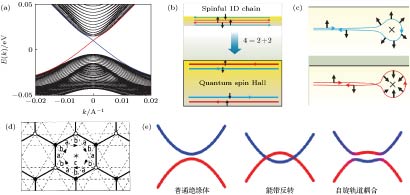
 下载:
下载:

